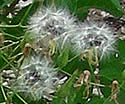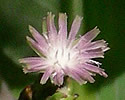Lactuca ludoviciana (Louisiana Lettuce)
| Also known as: | Prairie Lettuce, Western Wild Lettuce |
|---|---|
| Genus: | Lactuca |
| Family: | Asteraceae (Aster) |
| Life cycle: | biennial, short-lived perennial |
| Origin: | native |
| Habitat: | sun; plains, prairies, open meadows, woodland openings |
| Bloom season: | June - September |
| Plant height: | 1 to 5 feet |
| Wetland Indicator Status: | GP: FACU MW: FACU NCNE: UPL |
| MN county distribution (click map to enlarge): |  |
| National distribution (click map to enlarge): |  |
Pick an image for a larger view. See the glossary for icon descriptions.
Detailed Information
Flower: 

![[photo of flower]](/udata/r9ndp23q/pd/lactuca-ludoviciana-786-t.jpg) Open, branching cluster of stalked flowers at the top of the plant and arising from upper leaf axils. Flowers are ¾ to 1 inch across with 20 to 50 rays (petals) that are pinkish purple to bluish, or sometimes yellow.
Open, branching cluster of stalked flowers at the top of the plant and arising from upper leaf axils. Flowers are ¾ to 1 inch across with 20 to 50 rays (petals) that are pinkish purple to bluish, or sometimes yellow.
![[photo of bracts]](/udata/r9ndp23q/pd/lactuca-ludoviciana-12-3-t.jpg) The bracts are variable in size, green often with purple tips, hairless, overlapping, appressed, and form a tube ½ to ¾ inch long.
The bracts are variable in size, green often with purple tips, hairless, overlapping, appressed, and form a tube ½ to ¾ inch long.
Leaves and stems: 


![[photo of upper stem leaves]](/udata/r9ndp23q/purple/lactuca-ludoviciana-louisiana-lettuce_0622_122638-t.jpg) Leaves are rather variable, the lower leaves up to 12 inches long and 8 inches wide, deeply lobed and coarsely toothed with sharp pointed teeth. Leaves become smaller and less lobed as they ascend the stem, the upper stem leaves about 4 inches long, 1½ inches wide, and unlobed. Leaves are stalkless, typically with 2 large lobes (auricles) at the base. Color is green to blue-green.
Leaves are rather variable, the lower leaves up to 12 inches long and 8 inches wide, deeply lobed and coarsely toothed with sharp pointed teeth. Leaves become smaller and less lobed as they ascend the stem, the upper stem leaves about 4 inches long, 1½ inches wide, and unlobed. Leaves are stalkless, typically with 2 large lobes (auricles) at the base. Color is green to blue-green.
![[photo of leaf underside]](/udata/r9ndp23q/pd/lactuca-ludoviciana-789423-3-t.jpg) Leaf surfaces are hairless, but with soft prickles along the edges and the midrib on the underside, sometimes also on major veins. Stems are hairless and unbranched except in the flower clusters. Leaves, stems and roots exude a brown sap when broken.
Leaf surfaces are hairless, but with soft prickles along the edges and the midrib on the underside, sometimes also on major veins. Stems are hairless and unbranched except in the flower clusters. Leaves, stems and roots exude a brown sap when broken.
Fruit: 
![[photo of fruit]](/udata/r9ndp23q/pd/lactuca-ludoviciana-8493-13-t.jpg) Flower heads form seed heads about 1½ inches in diameter with the bracts spreading out as seed matures. Seed is dark brown to nearly black, flattened, oval-elliptic, with a slender beak about as long as the seed body, and a tuft of white hairs at the tip of the beak.
Flower heads form seed heads about 1½ inches in diameter with the bracts spreading out as seed matures. Seed is dark brown to nearly black, flattened, oval-elliptic, with a slender beak about as long as the seed body, and a tuft of white hairs at the tip of the beak.
Notes:
While Louisiana Lettuce may have either blue or yellow flowers, they are larger than the flowers of either Tall Blue Lettuce (Lactuca biennis), or Wild Lettuce (L. canadensis). L. biennis is further distinguished by the lack of auricles on leaves, winged leaf stalks, and gray-brown hairs on the seeds. L. canadensis is further distinguished by the lack of prickles on leaf edges, having only 15 to 20 rays on the flowers, and usually being a rather taller plant. The non-native Prickly Lettuce (L. serriola) also has prickles along the leaf midveins, but has smaller yellow flowers with only 12 to 20 rays.
Native Plant Nurseries, Restoration and Landscaping Services ↓
More photos
 Louisiana Lettuce plant
Louisiana Lettuce plant Louisiana Lettuce plant
Louisiana Lettuce plant Louisiana Lettuce habitat
Louisiana Lettuce habitat early growth
early growth early growth
early growth more flowers, with Stiff Goldenrod
more flowers, with Stiff Goldenrod
Photos by K. Chayka taken in her backyard garden in Ramsey County. Photos courtesy Peter M. Dzuik taken at Ordway Prairie, Pope County, and his gardens.
Comments
Have you seen this plant in Minnesota, or have any other comments about it?
on: 2019-07-13 19:03:26
I think it was this one. Anyway to post a picture? It was not blooming. Just showed the same growth form as depicted on this page and had soft prickles on the midrib and along leaf margins.
on: 2019-07-13 19:19:40
Elizabeth, if the leaves had prickles on the midrib that would make it prickly lettuce, Lactuca serriola.






